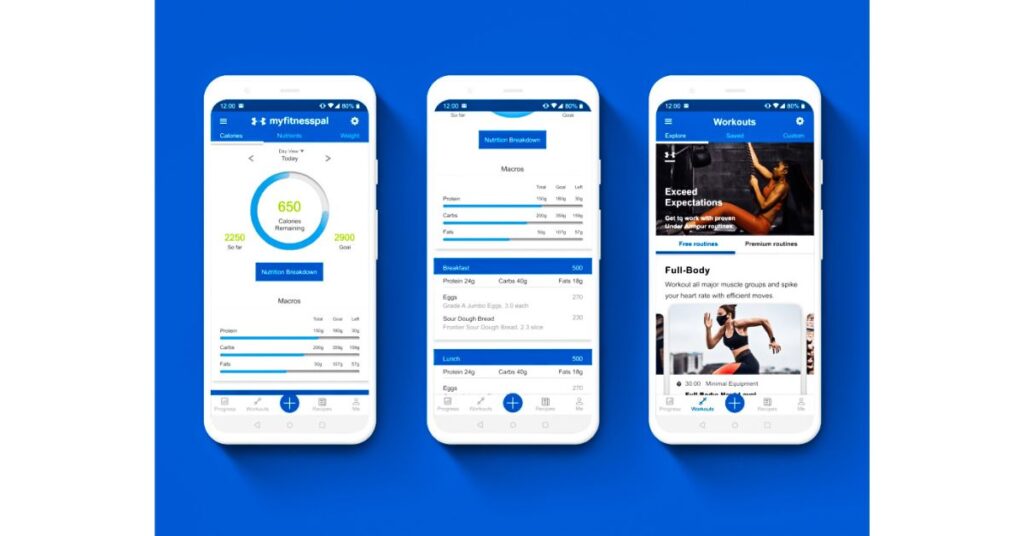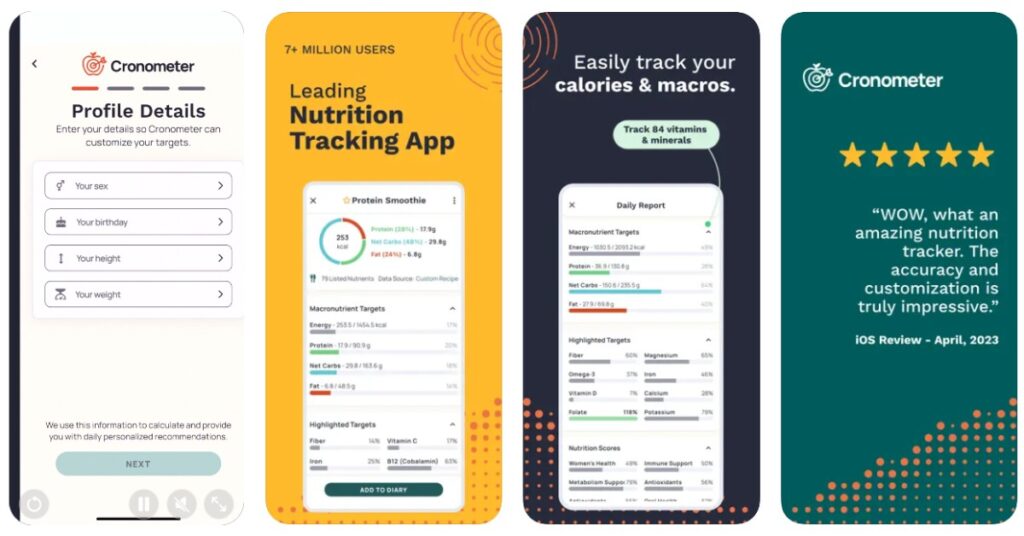In the nutrition-tracking and calorie-counting arena, two contenders – Cronometer and MyFitnessPal are the veteran and rising challengers, respectively.
Both provide insights into daily and historical data to let users identify trends and patterns. Since both platforms are amazing, now the question comes which one to choose?
Well, to make your work easier, we have given a detailed MyFitnessPal vs Cronometer comparison so that you can easily decide which calorie-counting platform you should choose.
MyFitnessPal vs Cronometer: Overview
MyFitnessPal
MyFitnessPal is one of the popular names in the world of health and fitness which has a massive user base and comprehensive features that make it convenient for you.
It helps you learn about your food habits, make smarter diet choices, monitor your diet, and even conquer your fitness goals.
MyFitnessPal shines for its strong community aspects, with social challenges and connections keeping you motivated always.
Further, it tracks your calories and macros with a barcode scanner and even gives personalized nutrition insights, thus offering tools and knowledge to build healthy habits for life.

Cronometer
Do you want to deep dive into your diet? Cronometer can help you with that! It craves its own niche as a data-driven haven for meticulous nutrition trackers.
It prioritizes scientific accuracy and in-depth analysis over user-generated information. So, it’s like a laboratory for your meals that offers meticulous tracking of both essential and hard-to-find micronutrients.
Unlike MyFitnessPal, its strength lies in its reliance on a verified database, powerful recipe analysis tools, and personalized reports that reveal potential deficiencies and imbalances in your diet.

Key Features and Functions
Food Logging and Tracking
MyFitnessPal: It has a massive user-generated entry, offering a variety of food database that makes tracking fun and engaging.
However, user-generated entries can sometimes be inaccurate. So, be prepared for a bit of detective work to make sure that the data is accurate.
Furthermore, though it keeps detailed track of macronutrients to keep you on top of your calorie game, it doesn’t delve deep into the fascinating world of minerals and vitamins.
Cronometer: It has verified and curated food database, making sure of data integrity but potentially missing unclear foods.
It also tracks macro and micronutrients, catering to detailed nutritional analysis and specific health goals.
Not only that, but it goes beyond calories, offering insights into how your food choices impact your overall health and well-being.
Recipes and Meal Planning
MyFitnessPal: It has a massive user-generated and curated recipes, offering variety and flexibility. Further, its drag and drop interface makes creating meal plans easy and visual.
Cronometer: Suggests recipes depending on your dietary needs and preferences, thus promoting overall well-being. Nonetheless, it has a smaller recipe database compared to MyFitnessPal and even possibly some popular dishes.
Goal Setting and Progress Tracking
MyFitnessPal: You can set specific goals for macronutrient distribution, specific goals for calorie intake, and exercise routine.
It also lets you set weight loss or weight gain goals and provides recommendations based on individual profiles. After you log your snacks, meals, and water intake, it tracks your progress daily.
Cronometer: Since it emphasizes micronutrient tracking, it lets you set goals for minerals, vitamins, and other essential nutrients.
You can also set goals for certain biometrics like blood pressure or cholesterol levels. Then, it provides detailed information on the food you’ve consumed, thus helping you meet your nutritional needs.
Social Features and Community
MyFitnessPal: It boasts a huge, active community with diverse users, fostering encouragement and sharing. It also offers challenges, groups, and friend connections to keep you engaged and accountable.
So, compete in friendly challenges to add a sprinkle of competitive spirit to your fitness journey and share your achievements, celebrate milestones, and receive kudos from fellow fitness enthusiasts.
Cronometer: Though it has a smaller community compared to MyFitnessPal, it is more focused on users passionate about detailed nutrition and holistic health.
It also offers educational resources, expert Q&A, and in-depth discussions on certain dietary approaches. However, it lacks the competitive challenges and group activities that MyFitnessPal offers for external motivation.
Sleep and Exercise Tracking
MyFitnessPal: It syncs with various fitness trackers to log exercise activities, and users can see how many calories they’ve burned.
Not only that, but it also tracks basic sleep duration and quality, highlighting trends and patterns. Since it only provides basic sleep data, there are no advanced tracking features like sleep stages or REM cycles.
Cronometer: Seamlessly integrates with wearables and other devices for comprehensive sleep and activity data.
It also offers detailed exercise metrics like pace, distance, and heart rate for enhanced performance analysis. However, unlike MyFitnessPal, it may not offer tracking for many exercises.
Premium Subscriptions
MyFitnessPal
You can easily sign up for a free account and start tracking your food, macros, vitamins, and other micronutrients to see how everything you consume supports your goals.
However, if you want to level up your goals and access advanced features like barcode scan, custom macro goals, and intermittent fasting, you can upgrade to MyFitnessPal Premium for $79.99 a year or $19.99 a month.
Before that, you can also start a one-month free trial. Once the trial ends, your subscription will auto-renew unless you cancel.
MyFitnessPal Free vs Premium: Which One Is Beneficial? [2024]
Cronometer
Though it offers a basic version for free, you can upgrade to premium versions – Gold and Pro to access advanced features.
The Cronometer Gold version costs $54.99 annually or $9.99 monthly. If you are a health & fitness professional, the Cronometer Pro is for you, which costs $39.99 a month.
All these plans offer a 30-day free trial, which you can try to find out whether it is worth for you or not.
User Interface and Ease of Use
Both platforms typically aim for a modern and intuitive design with a user-friendly dashboard. Moreover, their barcode scanning functionality makes it easier to quickly enter food.
Not only that, but they both provide charts and graphs to visualize data trends. Nevertheless, they both cater to different requirements.
While MyFitnessPal is for a broader audience, focusing on overall fitness and weight management, Cronometer has a specialized approach, emphasizing detailed nutrient tracking and a more holistic view of health.
However, Cronometer can be intimidating for those who are not familiar with data-driven interfaces and it also requires more exploration and familiarity compared to MyFitnessPal.
Additional Features
MyFitnessPal
- Ability to create and save custom meal plans to stay on track with your goals.
- Participate in fun and motivating challenges with other users to keep yourself engaged.
- Swiftly log food by scanning its barcode with your phone’s camera.
- Tailored coaching plans for weight loss.
- Extensive community forums and recipe sharing.
- Integrations with several fitness trackers and health apps.
- Offers a large selection of pre-logged restaurant chains and menu products.
Cronometer
- Set goals tailored to various health concerns like hypertension, diabetes, or veganism.
- Ability to upload your lab results to get insights into how your diet impacts your biomarkers.
- Get personalized reports on specific nutrients or timeframes for a deeper understanding of your dietary trends.
- Offers accounts for food pairings and cooking methods to provide a more accurate picture of nutrient absorption.
- Advanced recipe analysis tool with recipe adjustments based on goals.
- Comprehensive food database of international and ethnic foods.
- Large micronutrient tracking along with unique compounds and trace elements.
Takeaways
MyFitnessPal | Cronometer | |
Strengths |
|
|
Weaknesses |
|
|
Ideal For |
|
|
Yazio vs MyFitnessPal: Which Is Better Fitness App? [2024] FatSecret vs MyFitnessPal: Which Is Better? [2024] MyFitnessPal vs Fitbit: Complete Comaprison [2024] MyPlate vs MyFitnessPal: A Head-to-Head Comparison for Nutritional Tracking
MyFitnessPal vs Cronometer: Final Words
What did you choose? It really depends on your individual needs and preferences. If you are focusing on general health, weight loss, or specific dietary needs – MyFitnessPal can be the right choice for you.
Whereas, if you want detailed micronutrient tracking for certain health goals and personalized health insights, Cronometer excels in it.
If you are still confused, it's better you try both Cronometer and MyFitnessPal to see which one you find more intuitive and helpful.
However, note that the best tracker is the one you’ll actually use consistently. So, explore, experiment, and find the app that makes your calorie-counting journey a fun and rewarding adventure.

![MyFitnessPal vs Cronometer: Which Is Better? [2024]](https://viraltalky.com/wp-content/uploads/2024/01/MyFitnessPal-vs-Cronometer.jpg)